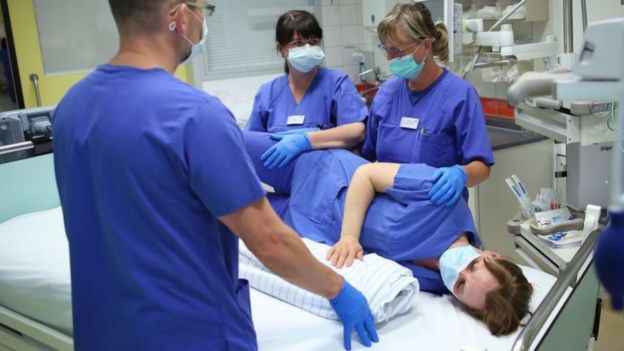
As the number of COD-19 cases in the world has increased, so have the images of hospitals in our minds. But when we see patients in intensive care with modern ventilators to help them breathe, one thing that seems strange to us is why most of them are lying on their stomachs. This old technique is called 'pronouncing' and has been shown to help some patients who are having difficulty breathing. It helps deliver more oxygen to the lungs. But there are also problems with this technique. Patients can be kept in this position for several hours to move the fluid in their lungs, which is making it difficult for them to breathe. Pron is derived from the Latin word pronus, which means to lean forward. This technique is being tested extensively on Uncode-19 patients who need intensive care. "Often patients with COD-19 do not get enough oxygen in their lungs, which can lead to damage," says Panagis Galiatsitos, an assistant professor of lung and intensive care medicine at Johns Hopkins University in the United States. "Even though they are being given oxygen, sometimes it is not enough. So we put them face down on their stomachs so that their lungs can expand. Dr. Galiatsitos says that the heaviest parts of the lungs are on our backs, so patients who lie face down have weight on their backs and it is a little difficult for them to get the oxygen they need.
In contrast, pruning techniques improve the flow of oxygen and help different parts of the lungs to function. "It could make a difference, we've seen it in many patients," says Dr. Galiatsitos. In March, the World Health Organization (WHO) recommended 12 to 16 hours a day for patients with ENCODE 19 who have acute respiratory distress syndrome (ARDS).
The World Health Organization says the technique can be used for children, but requires trained staff and additional expertise.
A study by the American Thoracic Society of Twelve Patients with ARDS, such as Code 19, found that patients who did not spend time in a state of pruritus had poorer lung function than others. ۔
Although this may seem like a simple procedure, there are many potential complications with pronouncing. It takes time for any patient to lie on his stomach and this requires many experienced professionals. "It's not easy," says Dr. Galiatsitos. It takes four or five people to do it effectively. This becomes even more difficult for hospitals where Code 19 patients are growing rapidly. According to Dr. Galiatsitos, Johns Hopkins University has allocated a team for prone to coronary heart disease. "So if a Code 19 patient is in an intensive care unit where staff do not have experience with the procedure, they will call a specialist team that will put the patient to bed." But changing the patient's lying position can also lead to many complications. "Our biggest concern is obesity. We need to be careful about people who have chest injuries and patients who are already on a ventilation tube or catheter tube. The technique is also said to cause more heart attacks and, in some cases, obstruction of the airways or breathing. The benefits of pruning were first discovered in the mid-1970s. But according to experts, its general use in hospitals around the world began in 1986. Luciano Gatinoni is one of the first doctors to work on this technique and successfully use it on patients. He is currently an honorary professor at Milan's Universita Statel and an expert in anesthesiology and resuscitation. Professor Gatinoni told the BBC that there had been a number of objections to Proning in the beginning, which he blamed on the very conservative attitude of the medical community. But now it is widely used, he says, that the only benefit of pruning is not to deliver more oxygen to the lungs. According to Professor Gatinoni, "When a patient is upside down, the force in his lungs spreads more evenly. 'Just think of the lung that is being given the mechanical energy of a ventilator: it's like being punched all the time. Clearly, the more power is distributed in parallel, the less damage there will be. 'A 2000 study in France found that patients who were prone not only had better oxygenation but also Their chances of survival also improved. After all, it is also a means of fighting the global disease that has killed tens of thousands of people and has yet to find a cure. "The best thing we can do at the moment is to use such therapies," says Dr. Galiatsitos.















0 Comments